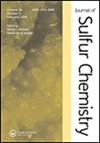Property and reactivity of polyselenides and polysulfides: a quantum chemistry study
IF 2.1
3区 化学
Q3 CHEMISTRY, MULTIDISCIPLINARY
引用次数: 0
Abstract
High-level ab initio and density functional theory were applied to investigate property and reactivity of polyselenides and polysulfides. With CH3XnH (X = S or Se) we found that the deprotonation energy (and pKa) of CH3SenH, ionization potential (IP) of, and CH3Sen−H bond dissociation energy (BDE) are lower than those of their sulfur counterparts. For n = 2, IPs and X−H BDEs are exceptionally small. The relative nucleophilicity of vary with substrates. However, CH3SenH are more nucleophilic than CH3SnH due to their due to their lower deprotonation energy. The nucleophilicity of selenolates versus thiolates are related to the chemical nature. Selenium is more electrophilic than sulfur.
多硒化物和多硫化物的性质和反应性的量子化学研究
应用高阶从头算和密度泛函理论研究了多硒化物和多硫化物的性质和反应性。用CH3XnH (X = S或Se),我们发现CH3SenH的去质子能(和pKa)、CH3Sen - H的电离势(IP)和CH3Sen - H键离解能(BDE)都低于它们的硫对应物。当n = 2时,IPs和X−H bde异常小。不同底物的相对亲核性不同。然而,CH3SenH比CH3SnH亲核性更强,因为它们的去质子能更低。硒酸盐与硫酸盐的亲核性与其化学性质有关。硒比硫更亲电。图形抽象
本文章由计算机程序翻译,如有差异,请以英文原文为准。
求助全文
约1分钟内获得全文
求助全文
来源期刊

Journal of Sulfur Chemistry
CHEMISTRY, MULTIDISCIPLINARY-
CiteScore
4.10
自引率
9.10%
发文量
38
审稿时长
6-12 weeks
期刊介绍:
The Journal of Sulfur Chemistry is an international journal for the dissemination of scientific results in the rapidly expanding realm of sulfur chemistry. The journal publishes high quality reviews, full papers and communications in the following areas: organic and inorganic chemistry, industrial chemistry, materials and polymer chemistry, biological chemistry and interdisciplinary studies directly related to sulfur science.
Papers outlining theoretical, physical, mechanistic or synthetic studies pertaining to sulfur chemistry are welcome. Hence the target audience is made up of academic and industrial chemists with peripheral or focused interests in sulfur chemistry. Manuscripts that truly define the aims of the journal include, but are not limited to, those that offer: a) innovative use of sulfur reagents; b) new synthetic approaches to sulfur-containing biomolecules, materials or organic and organometallic compounds; c) theoretical and physical studies that facilitate the understanding of sulfur structure, bonding or reactivity; d) catalytic, selective, synthetically useful or noteworthy transformations of sulfur containing molecules; e) industrial applications of sulfur chemistry; f) unique sulfur atom or molecule involvement in interfacial phenomena; g) descriptions of solid phase or combinatorial methods involving sulfur containing substrates. Submissions pertaining to related atoms such as selenium and tellurium are also welcome. Articles offering routine heterocycle formation through established reactions of sulfur containing substrates are outside the scope of the journal.
 求助内容:
求助内容: 应助结果提醒方式:
应助结果提醒方式:


